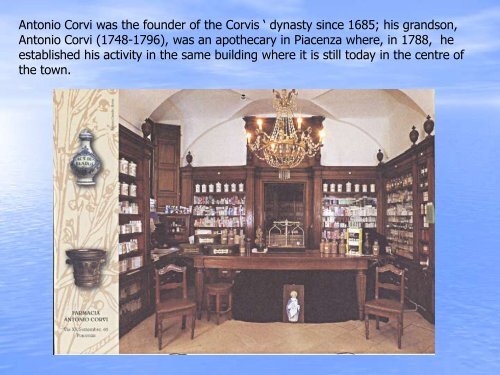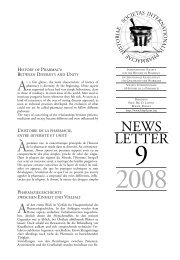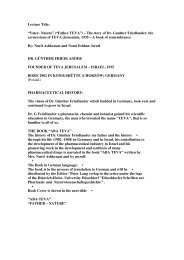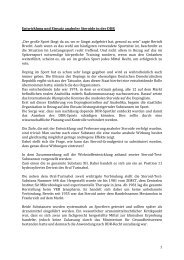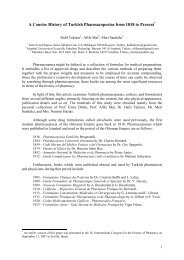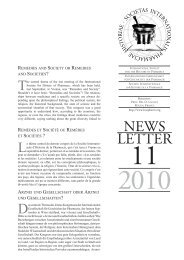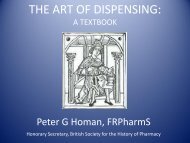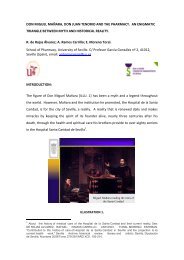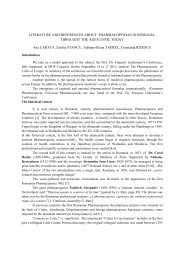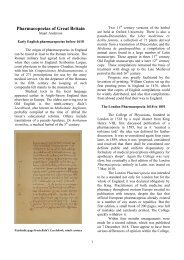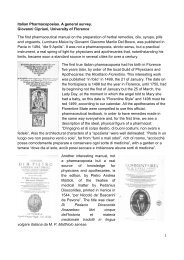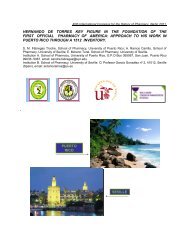Antonio Corvi was the founder of the Corvis â dynasty since
Antonio Corvi was the founder of the Corvis â dynasty since
Antonio Corvi was the founder of the Corvis â dynasty since
Create successful ePaper yourself
Turn your PDF publications into a flip-book with our unique Google optimized e-Paper software.
<strong>Antonio</strong> <strong>Corvi</strong> <strong>was</strong> <strong>the</strong> <strong>founder</strong> <strong>of</strong> <strong>the</strong> <strong>Corvi</strong>s „ <strong>dynasty</strong> <strong>since</strong> 1685; his grandson,<br />
<strong>Antonio</strong> <strong>Corvi</strong> (1748-1796), <strong>was</strong> an apo<strong>the</strong>cary in Piacenza where, in 1788, he<br />
established his activity in <strong>the</strong> same building where it is still today in <strong>the</strong> centre <strong>of</strong><br />
<strong>the</strong> town.
He also started to collect all <strong>the</strong> most scientific and up-to-date works about<br />
pharmacy, so laying <strong>the</strong> foundations <strong>of</strong> a really enlightened science.
we can find an outstanding list <strong>of</strong> texts about <strong>the</strong> pharmaceutical science in in <strong>the</strong><br />
XVIII century …<br />
A science that takes into account <strong>the</strong> latest<br />
discoveries about chemistry
On <strong>the</strong>ir arrival in 1796 <strong>the</strong> French marked a turning point in Italy also in <strong>the</strong><br />
scientific field …<br />
The complete collection <strong>of</strong> <strong>the</strong> “Annales de chimie” kept in <strong>the</strong> Farmacia <strong>Corvi</strong><br />
Library is an evidence <strong>of</strong> this trend.
Antoine Laurent Lavoisier, <strong>the</strong><br />
<strong>founder</strong> <strong>of</strong> <strong>the</strong> magazine<br />
“Annales”, <strong>was</strong> <strong>the</strong> author <strong>of</strong> <strong>the</strong><br />
well-known Traité Elémentaire de<br />
Chimie.
This work <strong>was</strong> published in Italy in<br />
1791 and received a warm welcome<br />
by <strong>the</strong> scientific audience …<br />
it had been masterfully translated<br />
by Vincenzo Dandolo, a great Italian<br />
chemist<br />
<strong>Corvi</strong> Library, Piacenza: LAVOISIER A.L.,<br />
Trattato Elementare di Chimica, voll. 2,<br />
Zatta A., Venezia,1791 (trad. V. Dandolo).
<strong>Corvi</strong> Library, Piacenza: MORVEAU M.M.<br />
de “Esame delle Affinità Chimiche”, Zatta A.,<br />
Venezia, 1791.<br />
In <strong>the</strong> same year ano<strong>the</strong>r important work<br />
<strong>was</strong> published in Venice: <strong>the</strong> translation <strong>of</strong><br />
“Méthode de nomenclature chimique” by<br />
<strong>the</strong> famous Louis Bernard Guyton de<br />
Morveau,
<strong>Corvi</strong> Library, Piacenza: BOME‟ A., Chimica<br />
Sperimentale e Ragionata, Pezzana F., Venezia,<br />
1781.<br />
Besides, <strong>the</strong> collection includes a<br />
translation <strong>of</strong> “La chimie expérimentale et<br />
raisonnée” by Antoine Baumé, a master<br />
apo<strong>the</strong>cary from Paris.
“Elementa Chemiae” by Herman<br />
Boerhaave, even though it <strong>was</strong> written in<br />
1724, represented never<strong>the</strong>less a guide to<br />
chemistry
<strong>Corvi</strong> Library, Piacenza: BOERHAVE H.,<br />
Elementa Chemie, Venetia, S. Colati, 1737.<br />
Of course this work, a milestone <strong>of</strong><br />
chemical science, is part <strong>of</strong> <strong>Corvi</strong><br />
Library .
When Nicolas Lémery died in 1715 at <strong>the</strong> age <strong>of</strong> 70, as many as 13 editions <strong>of</strong> his best<br />
known “Cours de Chimie” had already been printed: …<br />
<strong>the</strong> edition dated 1697 forms part <strong>of</strong> <strong>the</strong> concerned library.<br />
<strong>Corvi</strong> Library, Piacenza: LEMERY N.,<br />
Cours de chymie,E. Michallet, Paris, 1697.
As you know Lèmery <strong>was</strong> <strong>the</strong> author <strong>of</strong> a milestone for<br />
pharmaceutical science: <strong>the</strong> “Pharmacopée Universelle” published in<br />
Paris in 1697.
Obviously our library can boast this work .<br />
<strong>Corvi</strong> Library, Piacenza: LEMERY N., Pharmacopée Universelle, Laurent D‟Hour,<br />
Paris, 1716. LEMERY NICOLÒ, Farmacopea Universale, Bertella e Perlini, Venezia,<br />
1767.
Twenty years earlier Moyse Charas,<br />
a famous French apo<strong>the</strong>cary,<br />
published a weighty volume about<br />
medicaments titled “Pharmacopée<br />
Royale”.
<strong>Corvi</strong> Library, Piacenza: CHARAS<br />
MOSIS, Pharmacopoea Regia Chymica, L.<br />
D<strong>of</strong>our, Geneve, 1684.<br />
The Latin version <strong>of</strong> this work,<br />
which is part <strong>of</strong> <strong>Corvi</strong> Library,<br />
<strong>was</strong> published some years<br />
later in Geneva.
<strong>Corvi</strong> Library, Piacenza: JUNCKERO J.,<br />
Conspectus Formularum Medicarum, Hertz G.,<br />
Venezia, 1727.<br />
At almost <strong>the</strong> same time, ano<strong>the</strong>r<br />
important work circulated throughout<br />
Europe: it <strong>was</strong> <strong>the</strong> “Conspectus<br />
Formularum” by Johan Juncker,<br />
pr<strong>of</strong>essor at <strong>the</strong> Royal Frederic<br />
University ...
<strong>Corvi</strong> Library, Piacenza: DIOSCORIDE ANAZARBEO,<br />
Della Materia Medica, trad. Montigiano, Firenze, 1547.<br />
As everybody knows,<br />
<strong>the</strong> pharmaceutical<br />
tradition is strictly<br />
connected with <strong>the</strong><br />
<strong>of</strong>ficinal herbs and <strong>the</strong>se<br />
are in <strong>the</strong>ir turn strictly<br />
connected with<br />
Dioscorides‟ De Materia<br />
Medica, a text that could<br />
not be missing in our<br />
library.
<strong>Corvi</strong> Library, Piacenza: DIOSCORIDE ANAZARBEO,<br />
Della Materia Medica, trad. Ruellio, Firenze, 1547.
<strong>Corvi</strong> Library, Piacenza: LINNE‟ C. , Systema<br />
Vegetabilium, Delamolliere , Falque, Lugduni<br />
Bernuset, 1796.<br />
Pharmaceutical botany became little<br />
by little a real, lively and dynamic<br />
science.<br />
Linnaeus‟ monumental work can be<br />
found in our library ...
<strong>Corvi</strong> Library, Piacenza: MORANDI J. B. ,<br />
Historia Botanica Practica, seu Plantarum quae<br />
ad usum Medicinae pertinent, Petri Francisci<br />
Malatestae, Mediolani, 1744.<br />
“Historia Botanica Practica” by Giovanni<br />
Battista Morandi is perfectly in line with<br />
this new vision <strong>of</strong> <strong>the</strong> vegetable kingdom
This text can be found in our<br />
library: it is <strong>the</strong> first edition<br />
dated 1744, a wonderful in<br />
folio volume ...
<strong>Corvi</strong> Library, Piacenza: BONNET C.,<br />
Contemplazione della Natura, Giovanni Vitto,<br />
Venezia, 1781.<br />
The library can also boast<br />
a valuable copy <strong>of</strong> Charles<br />
Bonnet‟s “Contemplazione<br />
della Natura” translated<br />
and commented by<br />
Spallanzani.
<strong>Corvi</strong> Library, Piacenza: SPALLANZANI L.,<br />
Fisica Animale e Vegetabile, G.M. Benaglia<br />
(Bassaglia), Venezia, 1782.<br />
We can also find a fully<br />
exhaustive booklet about<br />
“Fisica Animale e Vegetale”<br />
published by Spallanzani in<br />
1782.
<strong>Corvi</strong> Library, Piacenza: ANTIDOTARIUM<br />
BONONIENSE, Leli e Volpe, Bologna, 1750.<br />
This <strong>of</strong>ficial pharmacopeia<br />
exerted a great influence on<br />
<strong>the</strong> new pharmaceutical<br />
culture
<strong>Corvi</strong> Library, Piacenza: ANTIDOTARIUM<br />
MEDIOLANENSE, J.B. Ferrarium, Mediolani,<br />
1668.<br />
The Antidotario Milanese (Milanese<br />
Pharmacopeia) <strong>was</strong> ano<strong>the</strong>r very<br />
important code …
<strong>Corvi</strong> Library, Piacenza : RICETTARIO<br />
SANESE, Bindi L.B., in 4°, 2 voll. Tomo I (XVIII,<br />
2, 370 pp.), Tomo II (4, 254, XXXVII pp.), Siena,<br />
1777.<br />
Moreover, <strong>Corvi</strong> Library includes<br />
ano<strong>the</strong>r modern, practical and<br />
exhaustive work: <strong>the</strong> Ricettario<br />
Sanese.
<strong>Corvi</strong> Library, Piacenza : PHARMACOPOEA<br />
AUSTRIACO PROVINCIALIS, J.T. Trattern,<br />
Viennae, Caes. Reg. Aulae, 1774.<br />
Towards <strong>the</strong> end <strong>of</strong> <strong>the</strong> XVIII<br />
century, <strong>the</strong> political and cultural<br />
trends <strong>of</strong> <strong>the</strong> Duchy <strong>of</strong> Parma e<br />
Piacenza had a stronger Austrian<br />
influence to <strong>the</strong> detriment <strong>of</strong> <strong>the</strong><br />
French one.
<strong>Corvi</strong> Library, Piacenza : CALESTANI<br />
GEROLAMO, Delle Osservationi, De Franceschi,<br />
Venezia, 1580.<br />
The <strong>of</strong>ficial Pharmacopeias, because<br />
<strong>of</strong> evident legal reasons, did not at<br />
all deal with <strong>the</strong> <strong>the</strong>rapeutic<br />
aspects, on <strong>the</strong> contrary, <strong>the</strong><br />
independent pharmacopeias, not<br />
tied to legal obligations …<br />
<strong>the</strong>y became little by little real<br />
practical reference handbooks
<strong>Corvi</strong> Library, Piacenza : DONZELLI G.,<br />
Teatro Farmaceutico Dogmatico e Spagirico, G.<br />
Valvasente, Venetia, 1696.<br />
Giuseppe Donzelli‟s “Teatro<br />
Dogmatico e Spagirico” is an<br />
exeple <strong>of</strong> it
<strong>Corvi</strong> Library, Piacenza : QUERCETANO G.<br />
(DUCHESNE),La ricchezza della Riformata<br />
Farmacopea, S. Curti, Venezia, 1684.<br />
The “Farmacopea Riformata” by<br />
Joseph Duchesne, also known as<br />
Quercetanus is an o<strong>the</strong>r exemple
<strong>Corvi</strong> Library, Piacenza : PLENCK G.B.,<br />
Farmacia Chirurgica, N. Pezzana, Venezia, 1786<br />
The “Farmacia Chirurgica” (Surgical<br />
Pharmacy) by Joseph Plenck, that<br />
can be found in our library,<br />
represents a typical example <strong>of</strong><br />
practical handbook concerning this<br />
particular aspect <strong>of</strong> “materiamedica”.
<strong>Corvi</strong> Library, Piacenza : CAPELLO G.B.,<br />
Lessico Farmaceutico Chimico, A. Graziosi,<br />
Venezia, 1769.<br />
During <strong>the</strong> XVIII century this<br />
kind <strong>of</strong> practical medical<br />
treatises had a really large<br />
circulation; <strong>the</strong> “Lessico<br />
Farmaceutico Chimico” by<br />
Giovanbattista Capello, <strong>was</strong><br />
an analogous text.
So, <strong>the</strong>se are all <strong>the</strong> scientific works that <strong>Antonio</strong> <strong>Corvi</strong>, apo<strong>the</strong>cary in Piacenza<br />
during <strong>the</strong> XVIII century, bequea<strong>the</strong>d his descendants who – by <strong>the</strong> way –<br />
continued to enlarge <strong>the</strong>ir legacy with o<strong>the</strong>r important texts that can still be found<br />
in <strong>the</strong> library <strong>of</strong> <strong>Corvi</strong> pharmacy.


